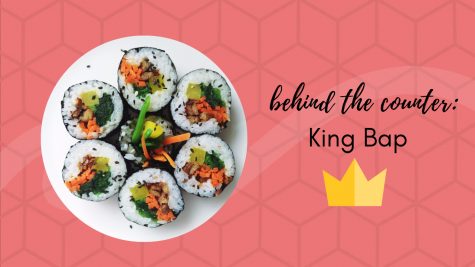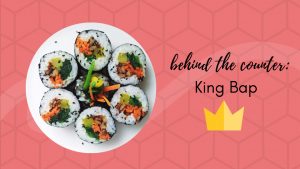King Bap earns its crown
September 12, 2017
Instead of creating your own pizza or burrito bowl, you can now build your own Korean-style kimbap at the recently opened restaurant King Bap.
Located in the small corner of the Crunch plaza in Diamond Bar, King Bap provides a modern twist to the traditional kimbap by offering a variety of dipping sauces, and serves meals that are both quick and healthy.
King Bap offers just two items on their main menu: kimbap rolls for $4.95 and Korean-style bowls for $5.95. However, with the number of different combinations you can create with the toppings, customers can make a different meal with every visit.
Kimbap is a Korean roll typically wrapped with rice, meat and vegetables in seaweed, while the bowl is essentially the same as a deconstructed roll. Both the kimbap and bowls contain the same toppings you choose, which include rice, vegetables and meat.
With a similar design to a dessert bar, the restaurant was modern and clean, with televisions playing K-pop music videos.
There are four steps in creating your quick meal. The first is choosing between the kimbap roll and the Korean bowl.
The second and third step is picking the vegetables and “protein” add-on. The last step is choosing your sauce. In addition, you can buy side dishes such as fish cake soup, spicy rice cake and barley tea.
At the recommendation of the friendly employee, I opted for the kimbap roll, which was the more popular option among regular customers.
For my roll, I chose spinach, cucumber, carrots, pickled radish and kimchi as my five vegetables, and tuna as my protein, which cost $1.00 extra. Other popular protein add-ons include fish cake, Korean bulgogi, spicy pork and tofu which range from 50 cents to $1.95.
I was a bit taken aback seeing that the add-ons were an extra charge, as I expected it to be included in the kimbap roll price.
However, seeing the employee add on a plentiful amount of tuna in my roll made the extra buck seem worth it.
In addition, the venue offered a large selection of vegetables, some of which I have never been exposed to in kimbap like burdock, asparagus, mushrooms and green beans.
I was recommended to try the original green house sauce, as it complemented my tuna roll. Having eaten kimbap all my life, I’ve never tried kimbap with a sauce as it wasn’t a part of the traditional roll. Looking through their sauce menu, I was fascinated by the variety the venue offered including two different kinds of original house sauce, a spicy Korean red paste sauce, sesame peanut, creamy Sriracha, ponzu, teriyaki and soy sauce.
As a Korean-American familiar with kimbap rolls, I was not disappointed by the tuna roll. The vegetables and tuna inside were extremely fresh, and I felt very healthy as none of the ingredients were fried.
The rolls were large enough to make the portion size sufficient for a convenient grab-and-go lunch. The kimbap roll tasted similar to those my mom makes for me, except the vegetables were a lot fresher, and the rolls were more aesthetically pleasing.
The house green sauce tasted like honey mustard with a kick of cilantro and it went surprisingly well with the tuna roll. It helped give the kimbap a more savory spice to it and added more distinct flavor.
The barley tea was refreshing, as it had no sugar or artificial sweetening. In addition, the fish cake soup balanced the meal, as the savory broth helped digest the kimbap. Paying $6.50 for eight rolls was not cheap, but for the quality and freshness of the kimbap, I didn’t feel I wasted my money.
Although you can buy cheaper kimbap rolls at a local Asian supermarket, having the opportunity to customize the rolls and have fresher ingredients is worth paying a bit extra.
Overall, for its price and quality, King Bap is a place I would visit to have a quick and healthy meal. It’s a great place to grab lunch or eat as a post-workout meal after hitting the gym nearby.











